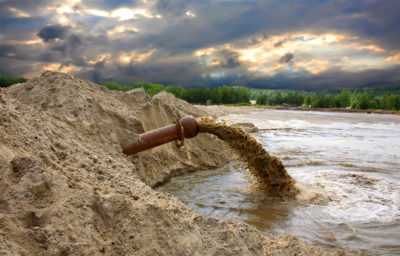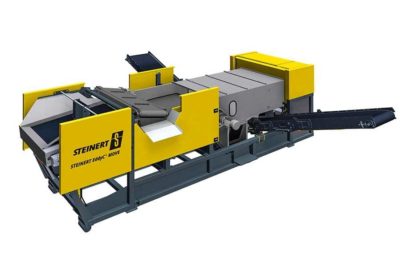
It’s common to see mining conferences present their moderated panels discussing “disruption” and Mining 2.0. The mining industry is always looking for new technologies to improve the way it operates. Disruptive technologies however require making big changes, not tweaks. True disruption is more than just automating haulage equipment or having new ways to visualize ore bodies in 3D.
Insitu leaching is a game changing technology that will eventually make a big difference. Read a previous blog at “Is Insitu Leaching the “Green Mining” Future”. Development of this technology will negate the need to physically mine, process, and dispose of rock. Now that’s disruptive.
However, if we must continue to mine and process rock, then what else might be a disruptive technology ?
Is dry processing a green technique
 Process water supply, water storage and treatment, and safe disposal of fine solids (i.e. tailings) are major concerns at most mining projects.
Process water supply, water storage and treatment, and safe disposal of fine solids (i.e. tailings) are major concerns at most mining projects.
Recently I read an article titled “Water in Mining: Every Drop Counts”.
That discussion revolved around water use efficiency, minimizing water losses, and closed loop processing. However another area for consideration is whether a future technology solution might be dry processing.
Dry processing is already being used
By dry processing, I am not referring to pre-concentration ore sorting or concentrate cleanup (X-ray sorting). I’m referring to metal recovery at the mineral liberation particle size.
In Brazil Vale has stated that it will spend large sums of money over the next few years to further study dry iron ore processing. By not using water in the process, no tailings are generated and there is no need for tailings dams.
Currently about 60% of Vale’s production is dry (this was a surprise to me) and their goal is to reach 70% in the next five years. It would be nice to eventually get to 100% dry processing at all iron ore operations. The link to the article is here “Vale exploring dry stacking/magnetic separation to eradicate tailings dams”.
Is dry grinding possible
Wet grinding is currently the most common method for particle size reduction and mineral liberation. However research is being done on the future application of dry grinding.
The current studies indicate that dry grinding consumes higher energy and produces wider particle size distributions than with wet grinding. However it can also significantly decrease the rate of media consumption and liner wear.
Surface roughness, particle agglomeration, and surface oxidation are higher in dry grinding than wet grinding, which can affect flotation performance.
Better understanding and further research is required on the dry grind-float process. However any breakthroughs in this technology could advance the low water consumption agenda.
You can learn more about dry grinding at this link “A comparative study on the effects of dry and wet grinding on mineral flotation separation–a review”.
Electrostatic separation
 Electrostatic separation is a dry processing technique in which a mixture of minerals may be separated according to their electrical conductivity. The potash industry has studied this technology for decades.
Electrostatic separation is a dry processing technique in which a mixture of minerals may be separated according to their electrical conductivity. The potash industry has studied this technology for decades.
Potash minerals, which are not naturally conductive, are conditioned to induce the minerals to carry electrostatic charges of different magnitude and different polarity.
In Germany, researchers have developed a process for dry beneficiation of complex potash ores. Particle size, conditioning agents and relative humidity are used to separate ore.
This process consumes less energy than conventional wet separation, avoiding the need to dry out the beneficiated potash and the associated tailings disposal issue.
Further research is on-going.
Eddy current separators
 The recovery of non-ferrous metals is the economic basis of every metal recycling system. There is worldwide use of eddy separators.
The recovery of non-ferrous metals is the economic basis of every metal recycling system. There is worldwide use of eddy separators.
The non-ferrous metal separators are used when processing shredded scrap, demolition waste, municipal solid waste, packaging waste, ashes from waste incineration, aluminium salt slags, e-waste, and wood chips.
The non-ferrous metal separator facilitates the recovery of non-ferrous metals such as aluminium, copper, zinc or brass.
This technology might warrant further research in conjunction with dry grinding research to see if an entirely dry process plant is possible for base metals or precious metals. Learn more at the Steinert website.
Conclusion
 Given the contentious nature of water supply and slurried solids at many mining operations, industry research into dry processing might be money well spent.
Given the contentious nature of water supply and slurried solids at many mining operations, industry research into dry processing might be money well spent.
Real disruptive technologies require making large step changes in the industry. In my opinion, insitu leaching and dry processing are two technologies that we will see more of over the next 20 years.
Ultimately the industry may be forced to move towards them due to environmental constraints. Therefore let’s get ahead of the curve and continue researching them.


Interesting discussion Ken, but I think a tailings facility will still be required in most cases to manage grinding rejects. Also, the issue of acid generation will remain with high sulphide rejects. Lots to think about though.
Thanks for the comments. Agreed that tailings is still generated, but it would be a dry stackable tailings. ARD would still be an issue but impermeable sealing is easier on dry stack than wet pond. Lots of bench scale research still to do.
If the mine is in a net positive precipitation zone (ie: BC) I think there will still be a need to manage (and possibly treat) water coming through the dry stack. However in net negative precipitation zones (ie: Australia) a dry grind method would work could work while possibly saving big $ on water supply AND on a TMF.